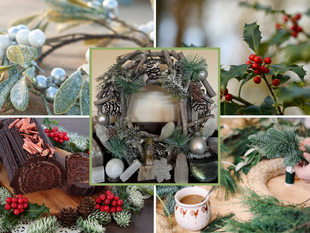.png)

The Pagan Wheel of the Year is a calendar that divides the year into eight Pagan festivals - or Sabbats - that occur every 6-7 weeks. These festivals mark the seasons and are celebrated by many modern Pagans and witches.
Pagan Festivals
Imbolc: Celebrates the halfway point between the Winter Solstice and the Spring Equinox. Marks the beginning of Spring and is observed on February 1st or 2nd. Symbolising new beginnings, it's a chance to clear away the old in preparation for the new. It is also linked to the Celtic goddess Brigid.
Ostara: The Spring Equinox is when the length of day and night are equal, and is celebrated around March 20th-22nd. It comes from the Germanic goddess Eostar, the goddess of fertility and spring.
Beltane: Marking the beginning of summer and observed on May 1st, Beltane comes from the Gaelic word Bealtaine which meaning bright fire. It's associated with fertility, new life, new beginnings, love, and abundance.
Litha: Also known as the Summer Solstice or Midsummer, this is the day with the longest hours of daylight and is celebrated on 21st June. The word Litha is derived from the Anglo-Saxon word for 'midsummer'.
Lughnasadh: This festival, also known as Lammas, is a Gaelic festival that marks the beginning of the harvest season. It is celebrated on August 1st, which is about halfway between the Summer Solstice and the Autumn Equinox. It's named after the Celtic god Lugh, who was the god of craftsmanship.
Mabon: Known as the Autumn Equinox, Mabon is a Celtic festival that celebrates the transition from summer to autumn around 20th-22nd September. Mabon is a time to express gratitude and celebrate the abundance of the harvest.
Samhain: The end of the harvest period and the start of the Pagan/Witches' New Year. Samhain is celebrated on 31st October and comes from the Irish word meaning 'summer's end'. Samhain is the Celtic root of Halloween.
Yule: Called the Winter Solstice, this day is celebrated on 21st December and marks the shortest day of the year and the beginning of winter. Pagan cultures of the past, such as the Norse and the Romans, celebrated the winter solstice with Yule logs, bonfires, gift-giving, feasting, and offerings.
By celebrating or acknowledging the Pagan festivals of the year, it is a way to ground yourself in nature and the cycles of the seasons.
A note from the author:
I want this information to be as accurate as possible from various sources whilst speaking of my own experiences. This is only my understanding of this topic and should not always be taken literally. Please make up your own mind and decide for yourself on the validity of what is written.
Want to learn more about what nature and spirituality can do for you? Join the membership for just £5 a month to get exclusive access to more content and an exclusive group to discover a community of like-minded people.





